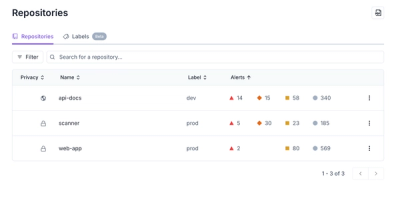
Product
Redesigned Repositories Page: A Faster Way to Prioritize Security Risk
Our redesigned Repositories page adds alert severity, filtering, and tabs for faster triage and clearer insights across all your projects.
.. image:: https://img.shields.io/pypi/v/pycorrelate.svg :target: https://pypi.python.org/pypi/pycorrelate
.. image:: https://img.shields.io/travis/tritemio/pycorrelate.svg :target: https://travis-ci.org/tritemio/pycorrelate
.. image:: https://ci.appveyor.com/api/projects/status/dcanybpqi2o1ecwi/branch/master?svg=true :target: https://ci.appveyor.com/project/tritemio/pycorrelate/branch/master
.. image:: https://readthedocs.org/projects/pycorrelate/badge/?version=latest :target: https://pycorrelate.readthedocs.io/en/latest/?badge=latest :alt: Documentation Status
Pycorrelate computes fast and accurate cross-correlation over
arbitrary time lags.
Cross-correlations can be calculated on "uniformly-sampled" signals
or on "point-processes", such as photon timestamps.
Pycorrelate allows computing cross-correlation at log-spaced lags covering
several orders of magnitude. This type of cross-correlation is
commonly used in physics or biophysics for techniques such as
fluorescence correlation spectroscopy (FCS <https://en.wikipedia.org/wiki/Fluorescence_correlation_spectroscopy>) or
dynamic light scattering (DLS <https://en.wikipedia.org/wiki/Dynamic_light_scattering>).
Two types of correlations are implemented:
ucorrelate <https://pycorrelate.readthedocs.io/en/latest/api.html#pycorrelate.pycorrelate.ucorrelate>:
the classical text-book linear cross-correlation between two signals
defined at uniformly spaced intervals.
Only positive lags are computed and a max lag can be specified.
Thanks to the limit in the computed lags, this function can be much faster than
numpy.correlate <https://docs.scipy.org/doc/numpy/reference/generated/numpy.correlate.html#numpy.correlate>.
pcorrelate <https://pycorrelate.readthedocs.io/en/latest/api.html#pycorrelate.pycorrelate.pcorrelate>:
cross-correlation of discrete events
in a point-process. In this case input arrays can be timestamps or
positions of "events", for example photon arrival times.
This function implements the algorithm in
Laurence et al. Optics Letters (2006) <https://doi.org/10.1364/OL.31.000829>.
This is a generalization of the multi-tau algorithm which retains
high execution speed while allowing arbitrary time-lag bins.
Pycorrelate is implemented in Python 3 and operates on standard numpy arrays.
Execution speed is optimized using numba <https://numba.pydata.org/>__.
pnormalize <http://pycorrelate.readthedocs.io/en/latest/api.html#pycorrelate.pycorrelate.pnormalize>__).ucorrelate <http://pycorrelate.readthedocs.io/en/latest/api.html#pycorrelate.pycorrelate.ucorrelate>__ argument from maxlags to maxlag.theory page <http://pycorrelate.readthedocs.io/en/latest/theory.html>__ in the documentation, showing the exact formula used for CCF calculations.FAQs
Fast and accurate timestamps correlation in python.
We found that pycorrelate demonstrated a healthy version release cadence and project activity because the last version was released less than a year ago. It has 1 open source maintainer collaborating on the project.
Did you know?

Socket for GitHub automatically highlights issues in each pull request and monitors the health of all your open source dependencies. Discover the contents of your packages and block harmful activity before you install or update your dependencies.

Product
Our redesigned Repositories page adds alert severity, filtering, and tabs for faster triage and clearer insights across all your projects.

Security News
Multiple deserialization flaws in PyTorch Lightning could allow remote code execution when loading untrusted model files, affecting versions up to 2.4.0.

Security News
NVD now marks all pre-2018 CVEs as "Deferred," signaling it will no longer enrich older vulnerabilities, further eroding trust in its data.